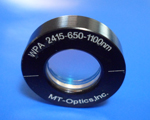- Home
- Products
- Waveplate Overview
- Waveplate Overview
- Low-Order Waveplate
- Dual Wavelength Waveplate
- Cemented Zero Order Waveplate
- Optically Contacted Zero Order Waveplate
- Air Spaced Zero Order Waveplate
- Ture Zero Order Waveplate
- Achromatic waveplate
Waveplate Overview
Principle of Waveplate
 Waveplates (retardation plates or phase shifters) are made from materials which exhibit birefringence. The velocities of the extraordinary and ordinary rays through the birefringent materials vary inversely with their refractive indices. The difference in velocities gives rise to a phase difference when the two beams recombine. In the case of an incident linearly polarized beam this is given by =2d(ne-no)/(-phase difference; d-thickness of waveplate; ne,no-refractive indices of extraordinary and ordinary rays respectively; l-wavelength). At any specific wavelength the phase difference is governed by the thickness of the retarder.
Waveplates (retardation plates or phase shifters) are made from materials which exhibit birefringence. The velocities of the extraordinary and ordinary rays through the birefringent materials vary inversely with their refractive indices. The difference in velocities gives rise to a phase difference when the two beams recombine. In the case of an incident linearly polarized beam this is given by =2d(ne-no)/(-phase difference; d-thickness of waveplate; ne,no-refractive indices of extraordinary and ordinary rays respectively; l-wavelength). At any specific wavelength the phase difference is governed by the thickness of the retarder.
Half Waveplate
The thickness of a half waveplate is such that the phase difference is 1/2-wavelength (ture-zero order) or some multiple of 1/2-wavelength (multiple order).
A linearly polarized beam incident on a half waveplate emerges as a linearly polarized beam but rotated such that its angle to the optical axis is twice that of the incident beam. Therefore, half-waveplates can be used as continuously adjustable polarization rotators. Half-waveplates are used in rotating the plane of polarization, electro-optic modulation and as a variable ratio beamsplitter when used in conjunction with a polarization cube.
Quarter Waveplate
The thickness of the quarter waveplate is such that the phase difference is 1/4 wavelength (ture-zero order) or some multiple of 1/4 wavelength (multiple order).
If the angle q (between the electric field vector of the incident linearly polarized beam and the retarder principal plane) of the quarter-waveplate is 45, the emergent beam is circularly polarized. When a quarter waveplate is double passed, i.e. by mirror reflection, it acts as a half waveplate and rotates the plane of polarization to a certain angle. Quarter waveplates are used in creating circular polarization from linear or linear polarization from circular, ellipsometry, optical pumping, suppressing unwanted reflection and optical isolation.
Types of Waveplate
|
Type
|
|
Feature
|
|
Zero Order
|
Cemented
|
Cemented by glue
Better Temperature Bandwidth
Wide Wavelength Bandwidth
Moderate damage threshold
|
|
Optical Contacted
|
No glue
Better Temperature Bandwidth
Wide Wavelength Bandwidth
Better damage threshold
Good wavefront and parallelism
|
|
|
Air Spaced
|
No glue, Mounted
Better Temperature Bandwidth
Wide Wavelength Bandwidth
High damage threshold
|
|
|
True Zero Order
|
Cemented
|
Cemented by glue
Better Temperature Bandwidth
Wide Wavelength Bandwidth
Moderate damage threshold
Excellent retardation performance
|
|
Single Plate
|
Single plate
Better Temperature Bandwidth
Wide Wavelength Bandwidth
High damage threshold
Only 1310nm, 1550nm available
|
|
|
Multi Order
|
Low Temperature Bandwidth
Low Wavelength Bandwidth
High damage threshold
Low cost
|
|
|
Dual Wavelength
|
Provide Specific Retardance At Two Different Wavelengths
|
|
|
Achromatic
|
Better Temperature Bandwidth
Very broad Wavelength Bandwidth
Cemented and air spaced available
|
|
How to choose a waveplate?
Firstly, you should know the retardation, is it a half waveplate or a quarter waveplate? Or even a special retardation? Then, you should know the size and working wavelength. This is important for waveplate. The retardation is different at different wavelength. It depends on wavelength. After confirm these conditions, we should choose a type of waveplate. If temperature bandwidth and wavelength bandwidth is important for you, you should choose zero order or true zero order. For zero order, optical contacted has better wavefront distortion and parallelism, air spaced has high damage threshold. True zero order is better than zero order waveplate at all parameters and can be used at more critical application. When temperature bandwidth and wavelength bandwidth is not a problem for you, multi order is a better choice, it is cheap. If a zero order or true zero order waveplate does not offer retardance over a wide enough wavelength band, one solution is to use an achromatic waveplate, it has over hundreds of nanometers bandwidth. For detailed information, please refer to above table or contact us.
Note: Kinds of sizes, wavelength are available upon request.



